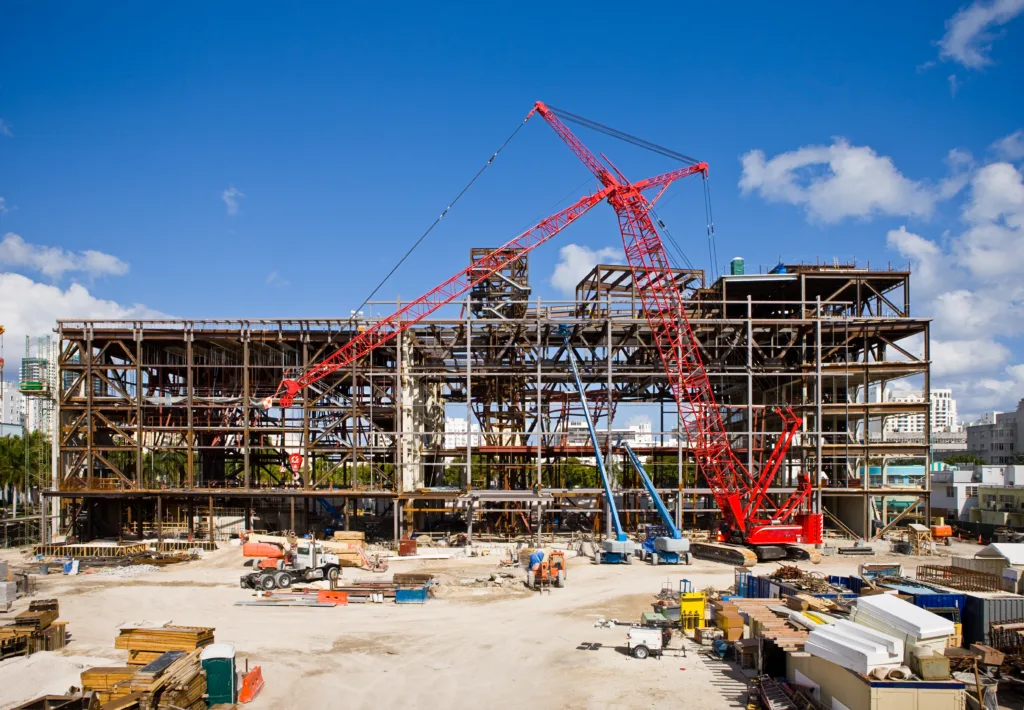The construction industry is a well-oiled machine where all the components, from labor to equipment and from planning to execution, need to work seamlessly together. Any disruption, be it small or large, can have a cascading effect, leading to delays, cost overruns, and increased risk. The solution to mitigating these issues? Improving construction site efficiency.
The importance of construction site efficiency is not a newfound revelation; it’s been a topic of discussion for as long as the industry has been in existence. Yet, as our modern world continues to evolve, introducing new technologies and concepts that offer potential for improvement, it’s crucial we revisit and explore how to enhance efficiency on construction sites.
Why? Because construction site efficiency isn’t merely a buzzword or a box to tick. It directly impacts the operational excellence of a project, translating into tangible benefits, such as on-time delivery, minimized waste, cost control, and enhanced quality. Additionally, a streamlined and efficient construction site promotes safety, worker satisfaction, and overall productivity, providing indirect but equally important benefits.
This blog post will delve into this topic, aiming to arm you with practical, implementable tips to drive efficiency on your construction site. We’ll explore ten areas you can focus on, each a cog in the machine that, when maintained well, can keep your construction site operating like a well-tuned orchestra. So, whether you’re a project manager looking to sharpen your project’s execution or a site supervisor eager to maintain a smooth operation, these tips will provide the guidance you need.
So, let’s embark on this journey of understanding and improving construction site efficiency, exploring strategies and methods that have the power to transform the way we build, one brick at a time.
Table of Contents
Understanding the Basics of Construction Site Efficiency
Before diving into the tips and techniques that can elevate your construction site’s performance, it’s essential to grasp the concept of construction site efficiency. So, what does it really mean?
Construction site efficiency, at its core, is all about maximizing the output achieved from a given set of inputs. It is the relationship between the effort you put into a project—the manpower, the equipment, the materials—and the end product. When we talk about improving efficiency, we’re really discussing how to get the most out of these resources while reducing waste and delays, ultimately leading to a successful project delivered on time and within budget.
However, achieving construction site efficiency is not a one-size-fits-all solution. It’s influenced by various factors, each of which plays a critical role in determining how efficiently a site operates. These factors range from the skill level and training of the workers to the quality and regular maintenance of the equipment. Material management, proper planning, and effective communication are equally critical, along with the integration of technology and continuous improvement practices.
These influencing factors aren’t standalone elements; they are intertwined. Improvements in one area often lead to improvements in another. For instance, effective communication can enhance safety measures on the site, while regular equipment maintenance can prevent sudden malfunctions, ensuring the project stays on track. Similarly, a well-trained workforce can make optimal use of technology, improving the overall productivity of the site.
The dynamic and interconnected nature of these factors is what makes construction site efficiency such a fascinating and complex subject. It’s also what allows us a broad scope for improvements. By focusing on various aspects, we can drive change and boost efficiency, even in areas we may initially overlook.
So now, with a basic understanding of construction site efficiency and its key influencing factors, let’s explore the ten tips that can help us improve it, one step at a time.
Tip 1: Proper Planning
There’s a popular saying in the construction industry: “Measure twice, cut once.” This nugget of wisdom underscores the value of planning in any construction project. Indeed, proper planning is like a detailed roadmap that guides every phase of the construction process.
A well-thought-out plan sets the tone for the entire project. It encompasses everything from the detailed project timeline, allocation of resources, anticipation of potential challenges, to the implementation of contingency plans. Proper planning can mean the difference between a project that stays on track and one that stumbles into costly delays and budget overruns.
How do we achieve proper planning? The key lies in both comprehensiveness and specificity. An effective plan doesn’t just outline what needs to be done. It details how it should be done, when it should be done, and by whom. It considers every possible scenario, plans for every eventuality, and leaves no stone unturned. It’s like a jigsaw puzzle – every piece needs to fit perfectly to reveal the complete picture.
In today’s digital age, several software solutions can help you streamline the planning process. Tools like Building Information Modelling (BIM), project management software, and other planning aids can bring greater precision and reliability to your project plan. These tools can help you manage tasks, allocate resources effectively, and predict potential bottlenecks before they turn into serious issues.
Additionally, proper planning is not just about creating an initial project plan; it’s also about continuous refinement. As the project progresses, unforeseen circumstances might arise. Changes in the project plan should be made and communicated effectively to all the stakeholders.
Ultimately, planning is a fundamental pillar of construction site efficiency. A thorough, detailed, and adaptive plan can set your project up for success, while a lackadaisical approach can doom it to failure. By investing time and energy in meticulous planning, you can greatly enhance the efficiency of your construction site, saving time, resources, and a whole lot of headaches down the line.
Tip 2: Effective Communication
Construction sites are bustling hubs of activity. They involve numerous stakeholders – from project managers, architects, and engineers to laborers and material suppliers. It’s like a complex symphony, where every musician has a part to play. To ensure this symphony plays harmoniously, the conductor – or in our case, the project manager – must communicate the score effectively to each musician. Hence, effective communication forms the crux of a well-functioning, efficient construction site.
Effective communication extends beyond just relaying messages. It’s about ensuring everyone on the site understands their role, the tasks at hand, deadlines, safety protocols, and the broader project objectives. It’s about fostering a culture of openness where questions, clarifications, and feedback are welcomed and addressed promptly.
In the context of construction site efficiency, good communication can make a world of difference. It can prevent misunderstandings and errors, promote better coordination between teams, and ensure everyone is on the same page, reducing unnecessary delays and rework.
One way to foster effective communication is through regular meetings and briefings. These can provide an opportunity to update the team on progress, address any issues or concerns, and align everyone on the next steps. In today’s tech-driven world, there are also a plethora of communication tools – like project management apps, instant messaging platforms, and collaborative software – that can facilitate quick and clear communication among team members, regardless of where they are.
However, the cornerstone of effective communication lies in its two-way nature. It’s not just about transmitting information but also about actively listening and responding. Encourage your team to voice their concerns, suggestions, and ideas. Often, those on the ground have insights that can lead to significant improvements in processes and outcomes.
In conclusion, effective communication is like the glue that holds all the other components of construction site efficiency together. By prioritizing clear, timely, and open communication, you can ensure smoother workflows, better collaboration, and, ultimately, an enhanced level of construction site efficiency.
Tip 3: Utilizing Technology
We live in an era where technology is a driving force in nearly every industry, and construction is no exception. From project planning to execution and maintenance, technology offers an array of tools that can significantly increase construction site efficiency.
Just think of the possibilities: Drones can provide real-time aerial imagery for site inspections and progress monitoring. Building Information Modeling (BIM) can help visualize the project in 3D, improving planning and design accuracy. AI-powered software can predict potential delays or conflicts in the construction schedule. And let’s not forget about simple yet effective mobile communication apps that keep the team connected and informed.
However, merely purchasing the latest tech gadgets and software is not enough. The true value of technology lies in its effective implementation and usage. Training your team to use these tools correctly is just as important as investing in the technology itself. If your team doesn’t understand the technology or if it’s not integrated into their daily workflows, even the most advanced tool can end up collecting dust in a corner.
Additionally, it’s important to remember that technology is a tool, not a magic wand. It is there to aid and enhance human decision-making, not replace it. Technology can provide valuable data and insights, but the interpretation and application of these insights still require human judgment.
A practical approach to leveraging technology is to start small and scale gradually. You don’t need to invest in every new tech gadget that hits the market. Instead, identify the areas where technology can provide the most benefit and start there. For example, if your projects often experience scheduling conflicts, a project management software might be a good place to start.
In essence, utilizing technology can be a game-changer when it comes to construction site efficiency. When selected wisely and implemented correctly, technology can help streamline processes, minimize errors, improve communication, and ultimately make your construction site more efficient and productive. It’s about working smarter, not just harder.
Tip 4: Skilled and Trained Labor
In the construction industry, human resources are every bit as important as physical resources. The skills and competence of your workforce can have a substantial impact on the efficiency of your construction site.
A highly skilled workforce can work more effectively, make fewer mistakes, and handle complex tasks with more precision. They are better equipped to use technology, understand safety protocols, and can adapt quickly to changes or unforeseen situations.
Training is the key to developing and maintaining a skilled labor force. However, it’s important to understand that training isn’t just a one-time affair, particularly in an industry as dynamic as construction. It should be an ongoing process, with refresher courses, new skill acquisition, and continuous learning opportunities.
Investing in worker training can have tangible benefits in the form of improved work quality, enhanced safety, and better job satisfaction, which can also lead to lower worker turnover. For instance, a worker trained in the latest construction techniques can complete their tasks more quickly and accurately, improving the overall project timeline and reducing the likelihood of rework.
It’s also worth noting that training should cover all aspects of the job, not just the technical skills. Soft skills like communication, problem-solving, and teamwork are equally important and can greatly contribute to construction site efficiency.
Remember, your workers are your most valuable assets. Empower them with the right skills, and they can play a crucial role in enhancing your construction site efficiency. A commitment to training is a commitment to quality and efficiency – and it’s an investment that pays for itself many times over.
So, make it a point to invest in your workforce, nurture their skills, and cultivate a culture of continuous learning. Because at the end of the day, a well-trained workforce is the backbone of any successful and efficient construction site.
Tip 5: Regular Equipment Maintenance
The construction industry is heavily dependent on equipment. From excavators and bulldozers to cranes and concrete mixers, these mechanical powerhouses are indispensable to any construction project. However, just as a well-tuned instrument is vital to a musician’s performance, well-maintained equipment is crucial to construction site efficiency.
Unexpected equipment breakdown can lead to costly delays, not to mention the additional expense of repairs or replacements. Furthermore, malfunctioning equipment can pose safety risks to your workers. Regular equipment maintenance helps avoid these pitfalls, ensuring your machinery operates smoothly and safely throughout the project.
The importance of equipment maintenance goes beyond just fixing a machine when it breaks down. In fact, a proactive, scheduled maintenance approach is more efficient and cost-effective than reactive maintenance. By identifying and addressing potential issues before they escalate, you can save time and money in the long run.
Scheduled maintenance should involve thorough inspections, routine servicing, and timely repairs. Today, you can also leverage technology for predictive maintenance, using sensors and software to monitor equipment condition and predict potential issues.
Keep in mind that regular maintenance also extends the lifespan of your equipment, offering better returns on your investment. Plus, well-maintained machines operate more efficiently, further enhancing construction site productivity.
Training your team on basic equipment care and safe usage practices is another vital aspect. A well-informed team can handle equipment correctly, reducing wear and tear, and can also spot and report any issues early on.
In essence, regular equipment maintenance is not a chore to be postponed, but a strategic function that promotes construction site efficiency. So, treat your machinery with care, schedule regular maintenance, and keep your construction site running like a well-oiled machine.
Tip 6: Material Management
Materials form a significant chunk of any construction project’s budget. Mismanagement of materials can lead to unnecessary expenses, waste, and delays – all detrimental to construction site efficiency. Therefore, effective material management is a crucial aspect to consider.
Material management covers the entire lifecycle of materials on your construction site: from procurement and storage to usage and disposal. Every stage presents opportunities for optimization.
Start with accurate forecasting. Having a clear idea of the types and quantities of materials required for each phase of the project can help prevent over-ordering or running short. Use past project data, if available, to make informed estimates.
Next, consider your procurement strategy. Building good relationships with reliable suppliers can ensure timely delivery of quality materials. Consider bulk purchasing for cost-effectiveness, but also take into account the storage space available and the risk of material degradation over time.
Once the materials are on-site, effective inventory management comes into play. Proper storage can prevent damage and loss due to environmental conditions or mishandling. It also helps maintain an organized site, promoting safety and workflow efficiency.
Equally important is the tracking of material usage. Regular inventory checks can help identify discrepancies early and ensure that the project doesn’t unexpectedly run out of materials. Here, technology can be a big help – inventory management software can track and manage your materials in real-time, providing valuable insights for decision-making.
Finally, don’t overlook waste management. Reducing, reusing, and recycling materials wherever possible is not only eco-friendly but also cost-effective.
In summary, effective material management can significantly boost construction site efficiency. It minimizes waste, reduces costs, and ensures the timely availability of the right materials at the right place, keeping your project on track. So, put a strong material management strategy in place – your project’s success (and your wallet) will thank you for it.
Tip 7: Implementing Lean Construction Practices
Lean construction might sound like a buzzword, but it’s a concept that holds substantial value when it comes to improving construction site efficiency. Rooted in the principles of lean manufacturing, lean construction aims to minimize waste of materials, time, and effort, while maximizing the value delivered to the clients.
At its heart, lean construction is about creating more value with fewer resources. It focuses on streamlining processes, eliminating non-value-adding activities, and promoting continuous improvement.
So, how can you implement lean practices on your construction site?
Start by analyzing your processes to identify areas of waste. Waste can take many forms – from physical waste of materials to waste of time due to waiting or rework. Don’t just look at the obvious; sometimes, waste can be hidden or built into how things are done.
Next, look for ways to optimize your processes. This could mean reorganizing workflows, improving coordination between teams, or using resources more effectively. The goal is to ensure that every step in your process adds value and moves the project closer to completion.
Collaboration is another key aspect of lean construction. Encourage a culture of teamwork and collective problem-solving. When everyone involved in a project – from architects and engineers to subcontractors and suppliers – work together towards a common goal, it leads to better solutions and more efficient outcomes.
Also, remember that lean construction isn’t a one-and-done deal; it’s a continuous journey. Keep seeking feedback, keep refining your processes, and keep looking for new ways to improve. Technology can be a powerful ally in this journey, providing data and insights to inform your decisions.
In essence, implementing lean construction practices can significantly boost construction site efficiency. It can help you deliver better results with fewer resources, improve project timelines, and enhance client satisfaction. So, embrace the lean philosophy and let it guide your journey towards a more efficient construction site.
Tip 8: Safety First
Safety may not be the first thing that comes to mind when thinking about construction site efficiency, but it plays an integral role. A safe construction site is, by its nature, a more efficient construction site. Let’s delve into why this is the case.
Firstly, workplace accidents can result in project delays, not to mention the human cost involved. Accidents require investigations, and can lead to temporary shutdowns, decreased morale, and even legal issues. Ensuring the safety of your workers can help prevent such disruptions.
On a broader level, a strong commitment to safety also promotes a more positive, productive work environment. Workers who feel safe are more likely to stay motivated, focused, and productive.
So, how can you prioritize safety on your construction site?
Start by establishing a comprehensive safety program. This should include regular safety training for all workers, strict adherence to safety protocols, and regular safety inspections. It’s important that everyone on the site understands the importance of safety and knows how to work safely.
Next, invest in quality safety equipment. From hard hats and safety boots to harnesses and protective eyewear, proper safety equipment is crucial to protect your workers.
Maintaining a clean and organized site is another simple yet effective safety measure. A clutter-free site reduces the risk of accidents caused by tripping, falling objects, or equipment mishaps.
Promote a culture of safety where everyone feels responsible for their own and their coworkers’ safety. Encourage workers to report any unsafe conditions or practices, and ensure there is a system in place to address such reports promptly.
Remember, a safe site is a more efficient site. By placing safety at the heart of your operations, you not only protect your workers but also improve the overall efficiency and productivity of your construction site. So, put safety first – because nothing is more important than the well-being of your team.
Tip 9: Continuous Improvement
The pursuit of construction site efficiency is a journey, not a destination. It’s not about reaching a point where you can say, “We’re efficient now, so our job here is done.” Instead, it’s about fostering a culture of continuous improvement, where you’re always looking for ways to do things better, smarter, and more efficiently.
Continuous improvement is all about making ongoing, incremental improvements over time. It’s about learning from past experiences, adapting to changes, and constantly striving for excellence.
One of the cornerstones of continuous improvement is feedback. Regularly seek feedback from all stakeholders – including workers, managers, suppliers, and clients. Listen to their experiences, consider their perspectives, and use their insights to identify areas for improvement.
Data analysis is another powerful tool for continuous improvement. By tracking and analyzing key performance indicators (KPIs) like project timelines, cost overruns, or defect rates, you can gain valuable insights into how well your processes are working and where they can be improved.
Also, encourage innovation and out-of-the-box thinking. Sometimes, the most effective improvements come from novel ideas or approaches. Foster an environment where everyone feels comfortable to share their ideas and contribute to improvement efforts.
Remember, continuous improvement isn’t about making massive, sweeping changes all at once. Rather, it’s about making small, manageable improvements consistently over time. This approach not only makes the process of improvement more manageable, but it also helps to create a culture where improvement is seen as a normal, everyday part of work, rather than a special project or initiative.
In essence, a commitment to continuous improvement can significantly boost your construction site efficiency. It’s about always striving to be better and never settling for “good enough.” So, embrace the journey of continuous improvement – your construction site, your team, and your clients will all benefit.
Tip 10: Performance Tracking and Feedback
The old adage “what gets measured gets managed” rings particularly true when it comes to improving construction site efficiency. Tracking performance and providing feedback are two essential tools that, when used together, can drive substantial improvements in efficiency.
Performance tracking involves monitoring key metrics or Key Performance Indicators (KPIs) that reflect how efficiently your construction site is operating. These could include things like project completion time, cost per unit, number of safety incidents, or worker productivity rates.
The goal here isn’t to drown in a sea of data, but rather to gather meaningful insights that can guide your decision-making and improvement efforts. It’s about identifying trends, uncovering bottlenecks, and pinpointing areas where performance may be falling short.
Modern construction management software can be invaluable in this regard, offering real-time tracking, automated reports, and even predictive analytics to help you stay on top of your site’s performance.
But tracking performance is just one side of the coin. The other side is providing feedback – both to your team and from your team. Regular, constructive feedback can help your workers understand what they’re doing well, where they need to improve, and how their individual efforts contribute to overall site efficiency.
It’s equally important to solicit feedback from your team. They’re the ones on the ground, after all, and their insights can help identify practical, on-the-ground improvements that might otherwise be overlooked.
Remember, performance tracking and feedback are not about pointing fingers or assigning blame. Instead, they’re about learning, improving, and working together towards a common goal: a more efficient, more productive construction site.
In conclusion, performance tracking and feedback are powerful tools to improve construction site efficiency. By knowing where you stand and where you need to go, you can steer your construction site towards greater efficiency and success.
Conclusion
Improving construction site efficiency is a multi-faceted task that requires attention, commitment, and a bit of strategic thinking. But the payoff is worth the effort – it means better project outcomes, higher profit margins, happier clients, and a more motivated workforce.
In this article, we’ve covered ten tips that can help you boost efficiency on your construction site, from embracing technology and implementing lean construction practices to prioritizing safety and fostering a culture of continuous improvement. However, this list is not exhaustive, and every construction project is unique. The most effective strategies will always be those that take into account the specific context, challenges, and goals of your project.
Moreover, improving efficiency is not a one-off project; it’s an ongoing journey. The construction industry is continuously evolving, and new technologies, techniques, and challenges are always on the horizon. Staying open to learning and adapting is key.
Remember, the quest for efficiency is not just about cutting costs or saving time (although these are certainly important benefits!). It’s also about building better – creating quality structures that meet client expectations, uphold safety standards, and contribute positively to our communities.
So, armed with these tips, we encourage you to take a fresh look at your construction site and see where you can make improvements. Here’s to building a more efficient, more successful future!
References
While this blog post doesn’t directly quote or paraphrase from specific sources, it is informed by a broad base of knowledge on construction site efficiency best practices. The principles and tips discussed are well-established within the construction industry and can be found in numerous industry resources. For further reading on the topics covered in this article, you might find the following sources useful:
- Koskela, L. (2000). An Exploration towards a Production Theory and its Application to Construction. VTT Technical Research Centre of Finland. This book delves into the concept of lean construction, a key theme in this article.
- Tommelein, I., & Ballard, G. (2016). Lean Construction Management. Springer International Publishing. A comprehensive guide to implementing lean practices in construction.
- Seppänen, O., Ballard, G., & Pesonen, S. (2010). The Combination of Last Planner System and Location-Based Management System. Lean Construction Journal. This research paper discusses the integration of planning and location-based management, both important for construction site efficiency.
- Hinze, J. (2012). Construction Safety. Pearson. A go-to guide on all things related to safety in the construction industry.
- Construction Industry Institute (CII). CII provides a wealth of resources on improving efficiency in the construction industry.
- Associated General Contractors of America (AGC). AGC offers various resources and educational materials on construction management and efficiency.
- Construction Financial Management Association (CFMA). CFMA provides resources on financial aspects of construction management, including cost-efficiency.
Please note that while these sources provide excellent additional information, the final authority should always be the best practices and regulations relevant to your specific context and location. Always make sure to adhere to local laws, regulations, and guidelines for construction projects.
Related posts
Read our other articles where you can find useful and relevant information about managing your construction business efficiently:
- How to Increase Your Construction Company’s Profitability
- How to be a better construction project manager?
- Master the Bid: Proven Strategies on How to Win More Construction Bids
- How to Manage Rising Costs in the Construction Industry?
- Enhancing Construction Efficiency: Key Factors and Strategies
About the Author

Taavi Kaiv
Taavi Kaiv is a construction specialist with over ten years of experience in the construction industry. Taavi is an accomplished construction project manager with many successful projects that have been completed under his guidance. Taavi holds a master’s degree in construction management from the Tallinn University of Technology. View profile





